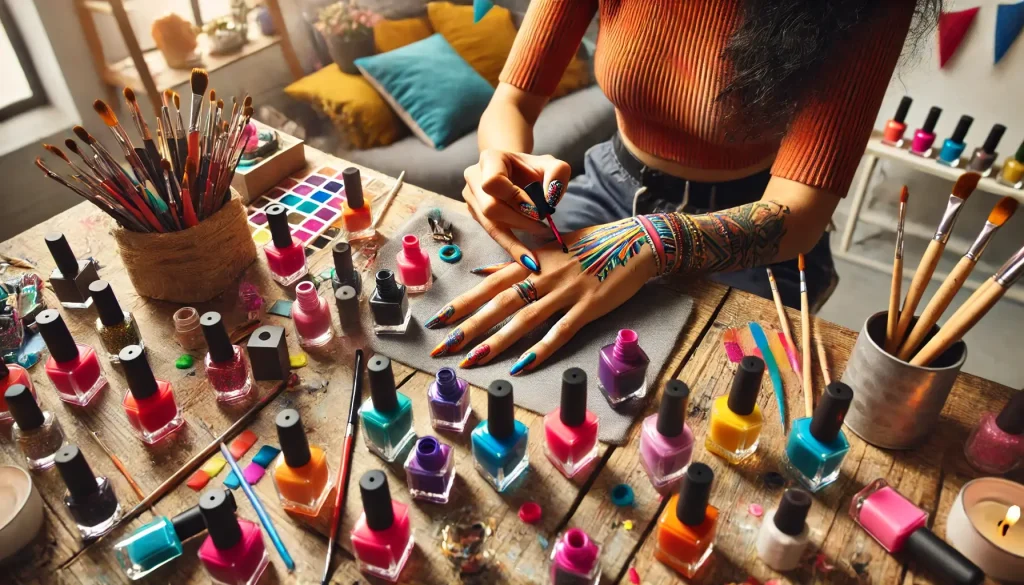The art of nail design is constantly evolving, and one of the most exciting ways to elevate your style is by experimenting with Nail Art Color Combos. Mixing hues not only adds a fresh pop to your manicure but also allows you to express your creativity with bold and harmonious designs. In this guide, we explore the principles of color theory, trending combinations, and step-by-step techniques to help you master Nail Art Color Combos that truly make a statement.

Indice
Understanding the Power of Color
Color plays a vital role in nail art, influencing mood, style, and overall impact. By carefully selecting and blending different hues, you can create designs that are both visually appealing and perfectly aligned with your personal aesthetic.
The Basics of Color Theory
- Complementary Colors: These are colors opposite each other on the color wheel, such as blue and orange or red and green. When paired together in Nail Art Color Combos, they create a vibrant, energetic look that immediately grabs attention.
- Analogous Colors: Colors that sit next to each other on the color wheel, like blue, teal, and green, produce a harmonious and soothing palette ideal for subtle yet elegant designs.
- Triadic Schemes: This involves using three colors that are evenly spaced around the color wheel. Triadic Nail Art Color Combos balance bold contrasts with visual harmony.
- Monochromatic Looks: For a more understated design, varying shades of a single color can be used to create depth and texture while keeping a clean and sophisticated vibe.
Understanding these principles is essential when crafting Nail Art Color Combos that are not only beautiful but also strategically balanced.
Trending Nail Art Color Combos
Keeping up with current trends can inspire your next design. Here are some of the hottest Nail Art Color Combos making waves in the beauty community:
1. Neon and Pastel Fusion
- Vibrant Meets Soft: Combining neon hues with pastels creates a striking contrast. Neon pink paired with soft lavender or neon green with baby blue results in a playful yet modern look.
- Seasonal Appeal: This combo is particularly popular in spring and summer, when bold colors reflect a fun, energetic vibe while still maintaining a delicate balance.
2. Earth Tones with a Pop of Metallic
- Rust, Olive, and Mustard: These earthy shades, when accented with a touch of metallic gold or silver, evoke a sophisticated yet grounded aesthetic.
- Modern Chic: Perfect for fall, this combination creates an elegant look that stands out without being overly flashy.
3. Bold Contrasts with Complementary Colors
- Blue and Orange, Red and Green: Use these complementary pairs to achieve high-impact designs. For instance, a deep navy base with neon orange accents offers a dramatic flair that’s ideal for evening events.
- Dynamic Energy: This approach is all about making a statement, ensuring your nails are the center of attention.
4. Monochromatic Gradients
- Shades of the Same Color: Gradually transitioning from a light to a dark shade of one color can create a stunning ombre effect. This technique adds depth and dimension while keeping your Nail Art Color Combos simple and elegant.
- Subtle Sophistication: Monochromatic gradients are ideal for a professional setting or minimalist style.
Techniques to Create Stunning Nail Art Color Combos
Bringing your color combo ideas to life requires a mix of creativity and technique. Here are some methods to help you master Nail Art Color Combos:
1. Sponging and Gradient Techniques
- Sponge Application: Use a makeup sponge to dab different shades onto your nail. This method creates a soft, blended gradient that looks seamless and artistic.
- Layering Colors: Apply two or three layers of polish in a gradual fade. Start with the lightest shade at the base and work your way to the darkest at the tip for a natural ombre effect.
2. Stripes and Geometric Patterns
- Tape and Brush: Apply striping tape to create sharp, clean lines that separate different color blocks. Fill in each section with a distinct hue to highlight your Nail Art Color Combos.
- Geometric Shapes: Experiment with triangles, squares, and chevrons. The contrast between geometric precision and flowing color transitions adds a modern edge to your designs.
3. Freehand and Dotting Techniques
- Freehand Painting: Use a fine brush to paint small, intricate patterns that incorporate multiple colors. Dots, swirls, and abstract lines can be layered to form a cohesive design.
- Dotting Tools: Utilize dotting tools to create uniform dots in different shades. Arranging these dots in a deliberate pattern can emphasize the beauty of your chosen Nail Art Color Combos.
4. Stenciling and Decals
- Use of Stencils: Stencils allow for precise application of multiple colors in a repeating pattern. This technique is excellent for achieving complex designs without requiring extensive freehand skills.
- Decals and Stickers: Pre-made decals can be combined with your own color choices to create unique patterns. They’re a quick way to incorporate intricate details into your Nail Art Color Combos.
Step-by-Step Tutorial: Bold Complementary Nail Art
Let’s create a bold, complementary nail art design using two contrasting colors. This tutorial will help you achieve a high-impact look perfect for making a statement.
Materials Needed:
- Base coat and top coat
- Two complementary nail polishes (e.g., blue and orange)
- Striping tape
- Fine nail brush and dotting tool
- Nail file and buffer
Step 1: Nail Preparation
- Clean and Shape: Remove any existing polish, trim your nails, and file them into your desired shape.
- Apply Base Coat: Use a base coat to protect your natural nails. Let it dry completely.
Step 2: Apply the Base Color
- Even Base: Choose one color (e.g., blue) and apply two thin coats. Allow each coat to dry before applying the next.
Step 3: Create the Accent Design
- Apply Striping Tape: Once the base color is dry, use striping tape to section off areas where you will add the contrasting color (orange).
- Fill in with Accent Color: Apply the orange polish into the taped areas using a fine brush or dotting tool. Ensure clean edges by gently pressing down on the tape.
- Remove Tape Carefully: Peel off the tape slowly to reveal sharp, crisp lines.
Step 4: Finishing Touches
- Enhance with Details: Add small dots or accent lines in either color to tie the design together.
- Seal with Top Coat: Finish with a generous layer of top coat to protect your design and enhance its shine. Allow the nails to dry completely.
Inspiration from the Pros
Professional nail artists are constantly pushing the boundaries with innovative Nail Art Color Combos. Here are some tips inspired by industry experts:
- Experiment Fearlessly: Don’t be afraid to mix unexpected colors. Sometimes, the most eye-catching designs come from experimenting with hues you might not normally pair.
- Follow Seasonal Trends: Adjust your color combos to suit seasonal moods. Bright and vibrant during summer, warm and earthy in fall, and cool, subtle shades in winter can all work beautifully.
- Stay Updated: Follow top nail artists on social media platforms like Instagram and Pinterest. Their work can provide inspiration and keep you informed about the latest Nail Art Color Combos making waves in the industry.
Tips for Long-Lasting Nail Art
While creating a stunning design is the first step, ensuring its longevity is just as important. Here are some tips to keep your Nail Art Color Combos looking fresh:
- Proper Top Coat Application: Always finish with a high-quality top coat to seal in your design and protect it from chipping.
- Avoid Excessive Water Exposure: Wear gloves when doing household chores to prevent premature wear of your nail art.
- Regular Maintenance: Touch up any areas that show wear before they compromise the overall design. Regular maintenance can extend the life of your nail art significantly.
Troubleshooting Common Challenges
Even with careful planning, you might encounter issues when creating your Nail Art Color Combos. Here are solutions to some common problems:
- Smudging: Ensure each layer of polish dries completely before applying the next. Consider using quick-dry formulas or accelerators.
- Uneven Application: Use thin, even layers of polish to avoid pooling. Practice steady hand techniques on a practice nail or piece of paper before applying on your nails.
- Color Bleeding: When using striping tape, make sure it’s firmly pressed down along the edges. Removing the tape slowly and carefully will help maintain clean lines.
Embrace Your Creativity
The true beauty of Nail Art Color Combos lies in the freedom to express your individuality. Whether you opt for a bold, high-contrast look or a subtle gradient that shifts seamlessly across your nails, let your creativity shine through. The more you experiment, the more you’ll discover what works best for your unique style.
Join the Community
Engage with other nail art enthusiasts to share ideas, techniques, and inspiration. Online communities, social media groups, and nail art forums are excellent places to exchange tips and keep up with the latest trends in Nail Art Color Combos. Collaborating and learning from others can take your skills to the next level.
Conclusione
Mixing hues for maximum impact is at the heart of stunning nail art. With the right understanding of color theory, trending combinations, and expert techniques, you can create Nail Art Color Combos that are both bold and beautiful. Whether you’re experimenting with complementary colors, monochromatic gradients, or unexpected pairings, each design is a chance to express your individuality and make a statement.
For more expert tips, detailed tutorials, and creative inspiration to elevate your nail art, visit our website at eu.artereciclada.com.br. Embrace the art of color, and let your nails tell your unique story.
